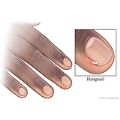Check Your Symptoms
Overview
Minor fingernail and toenail problems are common. At one time or another, almost everyone has caught a nail on something, causing it to rip. Or they have smashed a finger in a door, leaving blood under the nail. These kinds of injuries can be quite painful, but they usually aren't serious. You can often relieve pain and prevent infection of minor nail problems at home.
Normally, fingernails grow about one-tenth of a millimetre each day. Toenails grow at about one-half or one-third the rate of the fingernails. Aging and diseases that decrease blood flow to the hands and feet may slow nail growth.
Common nail changes
Common changes to nails include:
- Splitting, peeling, or brittle nails.
-
These are common problems that develop when your hands are often exposed to water, strong soaps, and other chemicals. You may be able to prevent some of these problems if you use lotion and avoid putting your hands in water often.
- Colour changes.
-
- Little white marks (leukonychia) often appear after minor injuries. They may last for weeks or months. They usually go away on their own.
- It's common for a nail to turn black after an injury. The black or purple-black colour is caused by blood under the nail. It will go away as the injury heals.
- Black, brown, or purple discoloration under a nail that has not been injured may be caused by melanoma.
- Changes in the shape or texture of nails.
-
These may occur for many reasons. Some nail changes, such as the forming of ridges, are normal with aging. Thick, brittle, or dark nails are more common in older adults who have poor circulation.
- Ingrown nails.
-
These are often caused by improper trimming, tight shoes, or heredity. Your nails may grow into the skin that surrounds them. This can cause pain, swelling, and infection. In rare cases, an abscess may form under a nail (subungual abscess).
- Separation from the nail bed.
-
After your nail separates from its nail bed, no matter what the reason, it won't reattach. Nails grow back slowly. It takes about 6 months for fingernails and up to 18 months for toenails to grow back attached to the nail bed.
- Infection and allergic reactions.
-
These are common problems caused by artificial nails. Remove the artificial nail if it causes problems.
- Fungal nail infections.
-
They can vary in appearance depending on the type of fungus or the location of the infection. The infected toenail usually turns white or yellow. It's not unusual for fungal nail infections to follow athlete's foot infections.
Other causes of nail problems
Nail problems can also be caused by:
- An injury to a nail.
- Hangnails. A hangnail may lead to a minor infection next to your nails (paronychia). This can cause the skin around the nails to become swollen and tender.
- Nail-biting. It can lead to fingertips that are red and sore and cuticles that bleed. Nail-biting also increases the chance of bacterial infections around your nail beds and in your mouth.
- Side effects of medicines, such as chemotherapy and antimalarial medicines.
- Diseases of the skin, such as psoriasis and eczema.
- Skin growths, such as warts, cysts, and moles.
- Other diseases such as Addison's disease, peripheral arterial disease, and HIV infection.
Check Your Symptoms
The medical assessment of symptoms is based on the body parts you have.
- If you are transgender or non-binary, choose the sex that matches the body parts (such as ovaries, testes, prostate, breasts, penis, or vagina) you now have in the area where you are having symptoms.
- If your symptoms aren’t related to those organs, you can choose the gender you identify with.
- If you have some organs of both sexes, you may need to go through this triage tool twice (once as "male" and once as "female"). This will make sure that the tool asks the right questions for you.
Many things can affect how your body responds to a symptom and what kind of care you may need. These include:
- Your age. Babies and older adults tend to get sicker quicker.
- Your overall health. If you have a condition such as diabetes, HIV, cancer, or heart disease, you may need to pay closer attention to certain symptoms and seek care sooner.
- Medicines you take. Certain medicines, such as blood thinners (anticoagulants), medicines that suppress the immune system like steroids or chemotherapy, or natural health products can cause symptoms or make them worse.
- Recent health events, such as surgery or injury. These kinds of events can cause symptoms afterwards or make them more serious.
- Your health habits and lifestyle, such as eating and exercise habits, smoking, alcohol or drug use, sexual history, and travel.
Try Home Treatment
You have answered all the questions. Based on your answers, you may be able to take care of this problem at home.
- Try home treatment to relieve the symptoms.
- Call your doctor if symptoms get worse or you have any concerns (for example, if symptoms are not getting better as you would expect). You may need care sooner.
Pain in adults and older children
- Severe pain (8 to 10): The pain is so bad that you can't stand it for more than a few hours, can't sleep, and can't do anything else except focus on the pain.
- Moderate pain (5 to 7): The pain is bad enough to disrupt your normal activities and your sleep, but you can tolerate it for hours or days. Moderate can also mean pain that comes and goes even if it's severe when it's there.
- Mild pain (1 to 4): You notice the pain, but it is not bad enough to disrupt your sleep or activities.
Symptoms of infection may include:
- Increased pain, swelling, warmth, or redness in or around the area.
- Red streaks leading from the area.
- Pus draining from the area.
- A fever.
Certain health conditions and medicines weaken the immune system's ability to fight off infection and illness. Some examples in adults are:
- Diseases such as diabetes, cancer, heart disease, and HIV/AIDS.
- Long-term alcohol and drug problems.
- Steroid medicines, which may be used to treat a variety of conditions.
- Chemotherapy and radiation therapy for cancer.
- Other medicines used to treat autoimmune disease.
- Medicines taken after organ transplant.
- Not having a spleen.
Seek Care Today
Based on your answers, you may need care soon. The problem probably will not get better without medical care.
- Call your doctor today to discuss the symptoms and arrange for care.
- If you cannot reach your doctor or you don't have one, seek care today.
- If it is evening, watch the symptoms and seek care in the morning.
- If the symptoms get worse, seek care sooner.
Seek Care Now
Based on your answers, you may need care right away. The problem is likely to get worse without medical care.
- Call your doctor now to discuss the symptoms and arrange for care.
- If you cannot reach your doctor or you don't have one, seek care in the next hour.
- You do not need to call an ambulance unless:
- You cannot travel safely either by driving yourself or by having someone else drive you.
- You are in an area where heavy traffic or other problems may slow you down.
Make an Appointment
Based on your answers, the problem may not improve without medical care.
- Make an appointment to see your doctor in the next 1 to 2 weeks.
- If appropriate, try home treatment while you are waiting for the appointment.
- If symptoms get worse or you have any concerns, call your doctor. You may need care sooner.
Self-Care
Home treatment can help relieve pain, prevent infection, and promote healing. Try these tips to help relieve pain from an injury to the nail.
- Apply ice, and prop up the injured nail.
Do this as soon as you can after the injury.
- Trim a torn or detached nail, and tape the nail in place.
- Try to drain blood from under the nail if you have pain.
Do not drain blood from under your nail if you have diabetes, peripheral arterial disease, or an immune system problem, or if you think a bone is broken.
- If you have an ingrown toenail, try soaking your toe.
You can also use a small pad of wet cotton. This helps the ingrown toenail heal on its own.
- Trim a hangnail.
You don't want the hangnail to tear your skin.
- Take off an artificial nail if you are having problems with it.
- Try gloves or lotions to protect weak, brittle, or splitting nails.
- Watch for any signs of a skin infection around a nail.
Caring for a torn or detached nail
Home treatment often helps relieve pain, promote healing, and prevent infection. Treatment may involve removing the nail, keeping the area dry to prevent infection, and waiting for a new nail to grow. The infection or skin condition that caused the separated nail will also need to be treated.
- File any sharp edges smooth, or trim the nail. This will help prevent catching the nail and tearing it more.
- Trim off the detached part of a large tear, or leave the nail alone.
- Cover the nail with tape or an adhesive bandage until the nail has grown out enough to protect the finger or toe.
- If you trim off the detached nail, you will have less worry about the nail catching and tearing.
- If you leave the detached nail in place, it will eventually fall off when the new nail grows in.
- Use scissors to remove the detached part of the nail if the nail is partly attached.
- Soak your finger or toe in cold water for 20 minutes after trimming the nail.
- Apply a thin layer of petroleum jelly, such as Vaseline, and cover the area with a non-stick bandage.
To prevent infection:
- Soak your foot or hand in a solution of 5 mL (1 tsp) of salt dissolved in 1 L (4 cups) warm water for 20 minutes, 2 or 3 times each day, for the next 3 days. Reapply petroleum jelly, and cover with a fresh adhesive bandage.
- Keep the nail bed dry, clean, and covered with petroleum jelly and an adhesive bandage until the nail bed is firm or the nail has grown back. Apply a new adhesive bandage whenever the bandage gets wet.
- Watch for signs of infection such as increasing heat, redness, pain, tenderness, swelling, or pus.
- Remove an artificial nail if it separates from the nail bed. If you leave it on, the long, artificial nail can tear the nail bed.
Have a doctor trim your nail if you:
- Aren't comfortable trimming the nail yourself.
- Have diabetes, peripheral arterial disease, or an immune system problem. These problems may cause reduced blood flow and loss of feeling in the feet. Untreated nail injuries can lead to infection, foot ulcers, and other serious problems.
Treating a nail infection
Try home treatment if you think you have an infection in the skin around your nail.
- Soak your foot or hand 2 to 3 times each day.
Use a solution of 5 mL (1 tsp) of salt dissolved in 1 L (4 cups) warm water. After soaking, apply a thin layer of petroleum jelly, such as Vaseline, and a bandage.
- Do not try to remove any part of the affected nail.
- Remove an artificial nail if you think you have an infection around or under a nail.
When to call for help during self-care
Call a doctor if any of the following occur during self-care at home:
- New or worse signs of infection, such as redness, warmth, swelling, pus, or a fever.
- Symptoms occur more often or are more severe.
Learn more
Preparing For Your Appointment
You can help your doctor diagnose and treat your condition by being prepared for your appointment.
Related Information
Credits
Current as of: March 22, 2023
Author: Healthwise Staff
Medical Review:
William H. Blahd Jr. MD, FACEP - Emergency Medicine
Adam Husney MD - Family Medicine
Kathleen Romito MD - Family Medicine
Current as of: March 22, 2023
Author: Healthwise Staff
Medical Review:William H. Blahd Jr. MD, FACEP - Emergency Medicine & Adam Husney MD - Family Medicine & Kathleen Romito MD - Family Medicine




